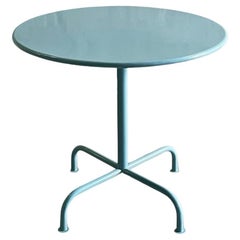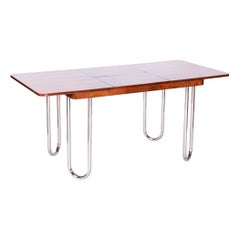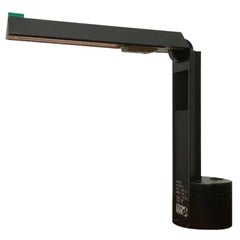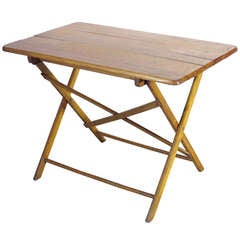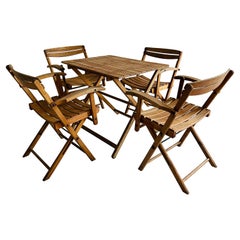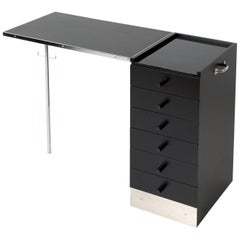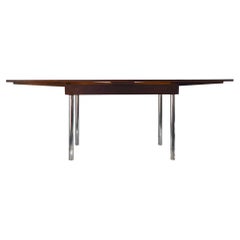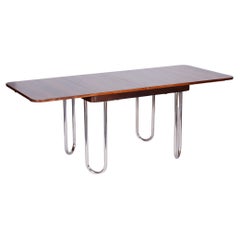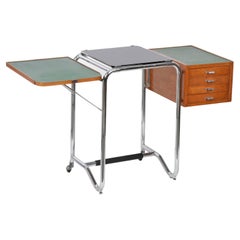Bauhaus Folding Table
to
9
3
11
1
1
1
11
1
1
7
1
6
1
1
8
7
6
4
3
11
4
3
2
1
12
12
12
2
1
1
1
1
Sort By
Folding Bauhaus Garden Table – by Max Ernst Haefeli for Embru, Switzerland
By Max Ernst Haefeli, Embru
Located in Debrecen, HU
renowned Swiss manufacturer Embru Werke AG. Featuring a folding tabletop, this piece reflects the Bauhaus
Category
20th Century Swiss Bauhaus Tables
Materials
Metal, Steel
$1,802
H 29.14 in W 31.5 in D 31.5 in
Czech Bauhaus Chrome Folding Dining Table by Halabala, 1930s, Restored, Walnut
By Jindřich Halabala
Located in Brandys nad Labem, Středočeský kraj
Czech Bauhaus folding dining table designed by Jindrich Halabala.
Period: 1930-1939
Material
Category
Early 20th Century Czech Art Deco Dining Room Tables
Materials
Chrome
$3,604
H 29.93 in W 47.25 in D 31.5 in
Postmodern Foldable Table Lamp, 1980s
Located in Hamburg, DE
Postmodern Foldable Table Lamp, 1980s, in Very Good conditions. Designed 1980 to 1989. European
Category
20th Century Bauhaus Table Lamps
Materials
Metal
Industrial Wood Folding Table. Bauhaus Era, Germany 1930 - 1940
By Bauhaus
Located in Karlsruhe, DE
Industrial wood folding table.
Bauhaus era, Germany 1920 - 1930.
Condition: Good, rare to
Category
Vintage 1930s German Bauhaus Coffee and Cocktail Tables
Erich Dieckmann Bauhaus Foldable Armchairs and Table, Germany, 1930s
By Erich Dieckmann
Located in Vienna, AT
Erich Dieckmann bauhaus foldable armchairs and table, Germany, 1930s.
Category
Vintage 1930s German Bauhaus Patio and Garden Furniture
Materials
Wood
$4,805 / set
H 27.56 in W 59.06 in D 39.38 in
Small Dresser Marcel Breuer 1926 with Foldable Top
By Marcel Breuer
Located in Berlin, DE
Marcel Breuer used the roll-top in the early days for famous institutions in Berlin, among others: Erwin Piscator and the Haus am Horn in the 1920s. In the early 1980s, manufacturer ...
Category
Vintage 1980s German Bauhaus Desks and Writing Tables
Materials
Glass, Bentwood
Bauhaus Oak and Chrome Folding Dining Table by Robert Slezák, 1930s
By Robert Slezák
Located in Prague, New Town
Rare Bauhaus oak and chrome-plated steel folding dining table, model ST1, designed by Robert Slezák
Category
Vintage 1930s Czech Bauhaus Dining Room Tables
Materials
Chrome, Steel
$3,123
H 31.5 in W 47.25 in D 33.47 in
Czech Bauhaus Folding Dining Table Designed by R. Slezak, 1930s, Restored, Oak
By Robert Slezák
Located in Brandys nad Labem, Středočeský kraj
Czech Bauhaus folding dining table designed by R. Slezak.
Period: 1930-1939
Material: oak
Category
Vintage 1930s Czech Bauhaus Dining Room Tables
Materials
Chrome
$3,664
H 30.52 in W 43.71 in D 33.27 in
Bauhaus Jean Burkhalter Chrome Tubular Foldable Desk with Drawers France 1930s
By Jean Burkhalter
Located in Roma, IT
Incredible Bauhaus chromed tubular and top black glass foldable desk. This fantastic item was
Category
Vintage 1930s French Bauhaus Desks and Writing Tables
Materials
Metal, Steel, Chrome
$2,643
H 27.17 in W 44.1 in D 16.93 in
Bauhaus Russian Tea Service Trolley Tray Bar Cart Folding Design, USSR
Located in Chula Vista, CA
For your pleasure: Russian service tea cart foldable compact design trolley bar service bar by
Category
Vintage 1950s European Mid-Century Modern Tray Tables
Materials
Chrome
$1,200
H 30.5 in W 27 in D 17 in
Terrific Bauhaus Era Folding Table
Located in New York, NY
Refined tubular steel folding table with cork top and walnut underneath. Beautiful proportions
Category
Vintage 1930s French Drop-leaf and Pembroke Tables
Materials
Walnut, Wood
'Jean' Folding Table or Desk by Eileen Gray, 1929
By Eileen Gray
Located in Costa Mesa, CA
'Jean' folding table or desk by Eileen Gray. Originally designed in 1929, this is a new production
Category
2010s German Bauhaus Desks and Writing Tables
Materials
Steel, Chrome
Get Updated with New Arrivals
Save "Bauhaus Folding Table", and we’ll notify you when there are new listings in this category.
Bauhaus Folding Table For Sale on 1stDibs
Choose from an assortment of styles, material and more with respect to the bauhaus folding table you’re looking for at 1stDibs. Frequently made of wood, chrome and metal, every bauhaus folding table was constructed with great care. There are 7 variations of the antique or vintage bauhaus folding table you’re looking for, while we also have 2 modern editions of this piece to choose from as well. Your living room may not be complete without a bauhaus folding table — find older editions for sale from the 20th Century and newer versions made as recently as the 21st Century. When you’re browsing for the right bauhaus folding table, those designed in Mid-Century Modern styles are of considerable interest. Poul Henningsen, Marcel Breuer and ClassiCon each produced at least one beautiful bauhaus folding table that is worth considering.
How Much is a Bauhaus Folding Table?
A bauhaus folding table can differ in price owing to various characteristics — the average selling price 1stDibs is $2,702, while the lowest priced sells for $950 and the highest can go for as much as $5,090.
Questions About Bauhaus Folding Table
- What is the best folding table?1 Answer1stDibs ExpertSeptember 28, 2021The best folding table depends on which room in your home or office you want it for. It also depends on the purpose of the folding table. On 1stDibs find folding tables for the dining room, folding end tables, coffee tables, tray tables and side tables as well.
More Ways To Browse
Mid Century Sun Lounger
The Fountainhead
Bauhaus Dressing Table
Tri Fold Dressing Mirror
Antique Tri Fold Vanity Mirror
Mid Century Teak King Bed
Saginaw Table
Teak Duck
Xx Glass Console
Birds Eye Maple Dressing Table
Birds Eye Maple Vanity
Antique Birdseye Maple Vanity
Chrome Folding Directors Chair
King Rice Bed
Thai Boat
Chicago Wire Chair Company
Japan Drop Leaf Table
Loja Saarinen
